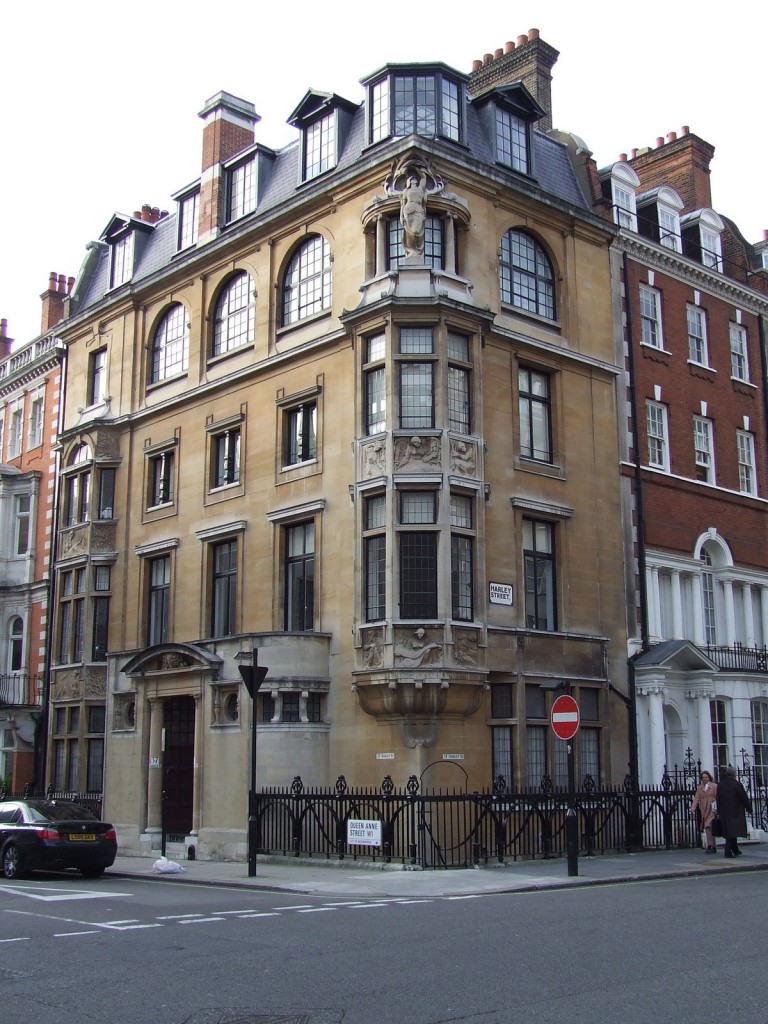Philip Wilkinson is the author of over 40 books, including The English Buildings Book, and a new book called The High Street, written in conjunction with a major BBC TV series. Happily for us, he’s also the curator of the English Buildings Blog, a firm favorite here at The Dabbler. In this series of posts, Philip talks us through some overlooked architectural gems…
London’s Harley Street is well known for its doctors’ houses and consulting rooms, making the district, as it were, the capital’s bedside manor. The street was first built in the second half of the 18th century, but there are also plenty of houses from the Victorian and Edwardian periods that left such a mark on this part of London. Number 37, on its prominent corner site, is one of the most spectacular.
It was designed by the architect Beresford Pite, who did several buildings for medical clients in the area and who threw at this one all his skill in composing the facades of a building and marshalling all kinds of architectural bits and pieces to make a coherent whole. The two frontages are full of incident – windows of different sizes and shapes, the ornate corner oriel, the doorway and curved pediment, the skyline with its big dormer windows. And all this fits together wonderfully.
But what really take the breath away are the sculptures that encourage the eye to linger on the facades. One represents poetry, a laurel-crowned figure with a lyre and volumes of Homer and Milton behind him. Another is a reclining figure with a telescope and a star, representing the science of astronomy. At the top is a caryatid holding up the heavy cornice. The whole collection constitutes a little-known London treasure, but the artist who created them was not a Londoner. His name was Frederick Schenk.
Frederick Schenk was the son of a German lithographer who settled in Edinburgh. As a young man he worked in his father’s lithographic business before training as an artist in Edinburgh and London, and working as a modeller for various potteries in Staffordshire. Although he was successful in the precise and painstaking work of the ceramic modeller, a change in the pottery market led him to find a new direction in his career. He became an architectural sculptor, and specialized in low-relief work, especially on public buildings – town halls and the like – designed by the architect Henry Hare.
There weren’t that many houses grand enough for Schenk’s stone sculptures, especially as by the turn of the century tilework and terracotta were so fashionable. But Beresford Pite, a man who combined skilful handling of shapes and masses with considerable decorative flair, gave him his chance on this corner site. Schenk picked up the scheme and ran with it, and his splendid reliefs of about 1900 still delight the eye.
Pite was an evangelical Anglican who worshipped at All Soul’s Church, not far from this building. Part of the subject matter of the Harley Street carvings reflects the architect’s faith. The lush leaves on the reliefs that flank the window in the picture are said to be an allusion to the book of Revelations 22:2: ‘…and the leaves of the tree were for the healing of the nations.’ Medicine, art, and religion come together then, and we remember an architect, a sculptor, and a whole medical community as we glance upwards in this busy street in the heart of the capital.












Fantastic stuff. I must remember to look up more.
It also helps you avoid seeing dogs in cars.
Good point, although I find that my default setting – staring blankly into the middle-distance and drooling – does that job pretty effectively too….
*This* is more my style.
Excellent. The capital’s ‘bedside manor’ 😉 I’ve started looking up more too, at the several Hapsburg-era eclecticist mini-masterpieces that we have near where I live. I suppose I should take some pictures of them one day.